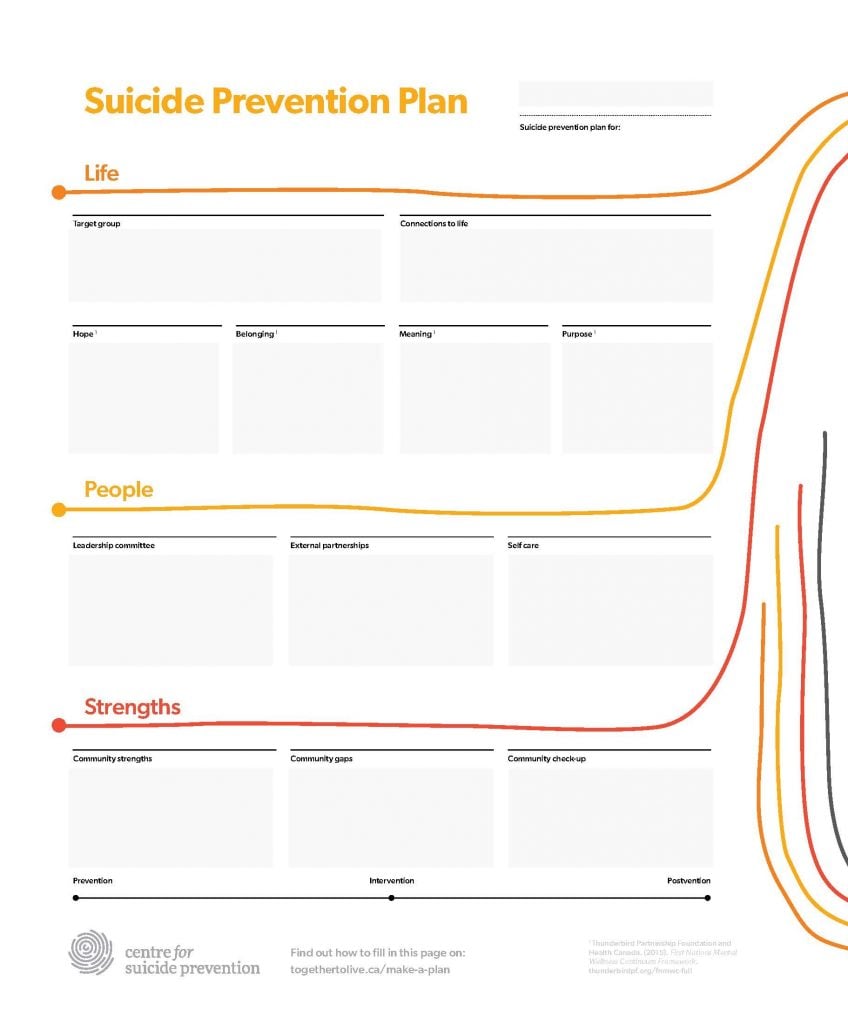Come Together

Introduction
The steps in this section are flexible – start at the place that makes the most sense for your community. If you’re not sure who your target population is, you may need to start by building a community profile. You may also choose to form a working committee before engaging with your target population.


Identify your target population
Start by identifying your target population. Your target population is the people who you hope will be impacted by the suicide prevention plan, for example, older adults. Your work will focus on preventing suicide in this population. They will be a key part of the work: you’ll engage with them and include them in the working committee. Being able to clearly identify your target population will reduce your overall work and help to build a strong foundation for all of your community prevention efforts.
Engage with your target population
Individuals in your target population are experts about themselves. They know what they need and can give insights and perspectives that no one else can. One way to engage your target population is by asking them about what, for them, promotes life, these are also known ‘protective factors.’
All protective factors have a basis in hope, belonging, meaning and purpose – universal human needs.
- Hope drives optimism about tomorrow; of the future of individuals and of families inseparably.
- Belonging is connectedness – relationships with family, community and nature. It is evident through the love, kindness, and respect we feel from others.
- Meaning is created by an attitude towards living. Meaning, like purpose, reminds us that our lives are worth living, no matter what, because life isn’t just about the day-to-day routines we create for ourselves, but instead about something deeper.
- Purpose creates an understanding that every person is sacred, that the physical body is “home” for the spirit, heart, and mind, all of which are interconnected to the other and work inseparably (Adapted from “First Nations Mental Wellness Continuum,” Thunderbird Partnership Foundation and Health Canada, 2015).
The First Nations Mental Wellness Continuum, a framework developed by Thunderbird Partnership Foundation with Indigenous and non-Indigenous partners including Health Canada, describes and explains these four aspects in action, and how aligning them brings wholeness. Read the Continuum for more information on hope, belonging, meaning, and purpose.
Bring your target group together and ask them:
- What gives you hope?
- Where do you have a sense of belonging?
- Where do you find meaning?
- What gives you purpose?
The group’s answers are invaluable for creating your suicide prevention plan: this is what connects them to life. Allow these answers to form the basis of the plan.
A suicide prevention plan will be most effective if it addresses issues raised by your target population themselves. These issues are likely significant contributors to the suicide problem and addressing them ensures your plan will be authentic and inclusive.
Form a working committee
Who should be involved?
To form your committee, build on existing and new relationships, within and outside of your community. Consider these questions – who in your community:
- is recognized for their wisdom and leadership?
- is already working in suicide prevention or mental health?
- is recognized as a helper and healer to those who have considered suicide?
Think about who might be able to help move the plan forward who is not in your community. Do you have any partnerships with people or organizations outside of your community that might be useful?
Don’t know where to start?
Here are some ideas for who to include on your committee:
- Members of your target population
- People who spend time with that target population
- Leaders involved in the community
- People who work with your target population
- People who are passionate about suicide prevention
Also consider some of the reasons why your population may consider suicide, and what brings them closer to life. For example, if your population is older adults, loneliness, isolation and a sense of burdensomeness can be issues. Once these concerns have been validated by the group, consider, for example, reaching out to an organization that connects young people and older adults and draw them into the planning process.
Need more ideas? Consider: suicide prevention advocates, mental health and addictions workers, people who have been impacted by suicide, advocates for your group, social workers, community outreach workers, educators, elected officials, faith/cultural leaders, family members, service clubs, coaches, local businesses, law enforcement, healthcare providers, policy makers.
Other things to consider:
- Who will care about this plan? Engage those who are passionate.
- What might prevent someone from joining the committee? Try to overcome barriers in advance.
- Who brings value to this working committee? Be discerning about who you include, considering the skills and passions of those you invite.
Bring committee members together
Before you meet, think about ways you might get to know each other at that meeting and begin building relationships. Introductions and ice-breaker questions, for example, are a good way of encouraging interaction and engagement.
Consider any logistics that may arise, for example, arranging a room to meet in, providing transportation, childcare, and food, if necessary.
Here are some sample agenda items for the first meeting:
- Introductions, including discussing strengths (e.g. experience with or knowledge of target population, has personal experience with suicide loss)
- Define the issue
- Establish the structure of the committee or terms of reference (e.g. how will the committee operate? How will decisions be made?)
- Explore the vision and mission
- Discuss recruiting new members
- Outline communication methods
Caring for the carers
Take steps to ensure you and the other committee members take care of yourselves physically, emotionally, mentally, and spiritually so you can maintain your own mental health as you move through this process.
It is typical to seek professional help when working in suicide prevention – this is difficult work. Ensure you and the committee members are aware of what mental health resources are available.
Building a community profile
Take some time to gather available information about suicide in your community. What’s happening in your community that is prompting you to act?
Come together as a working committee to fill out a community profile, using:
- knowledge that you have as a group
- anecdotes from your community
- data like suicide statistics
After reviewing the information available to you, answer the following questions:
- Who is being affected by suicide in the community? (Note location, age, sex, gender, ethnicity or other relevant demographic information)
- How are these people dying by suicide?
- Why are they dying by suicide? (Note factors like mental health issues, social isolation)
- What is happening in the community? What is prompting this work?
Recognizing community strengths
All communities have strengths. This next activity is an opportunity to map community strengths, consider which ones could be expanded and identify what gaps may exist (what’s missing).
Community asset map
A community asset map can be used to capture strengths, opportunities to expand, and gaps present in your community.
Don’t worry about connecting the asset map resources to suicide prevention – if there are resources and programs directly connected to suicide prevention of course, list them, but, as your target population likely told you, it’s not only crisis lines and counselling that prevent suicide. Suicide prevention is anything that promotes life. Events, hobby groups, and even outdoor spaces are also suicide prevention.
What’s great in your community? Brainstorm community assets. Consider:
- Existing programs and services
- Existing resources
- Community facilities (e.g. swimming pool, arena)
- External partnerships with organizations, leaders, institutions
- Other available programs, services and resources outside the community
- Facilities and services near the community (e.g. public transit, library, hospital, park)
Look at all the assets you already have – you’ll probably have more than you thought! These assets can be used as part of your suicide prevention plan.
Connecting existing activities that prevent suicide or create positive community to your suicide prevention plan can help leverage current investment. These activities likely already have funding, backing, and person-power behind them. Begin thinking about how these activities could be coordinated and integrated into your plan. Also, take some time to reflect on what’s not working, or not working to its potential. What can be adapted? Does anything need to be abandoned? Finally, add your wish list. What would you like to add to your community?
Community check-up
Now add the specific suicide prevention activities in your community.
Suicide prevention activities range from Prevention, Intervention and Postvention (PIP). Activities from each section are integral in a life promotion plan. It is helpful to think of PIP as a continuum instead of three distinct categories.
- Prevention (Hope): Activities that promote life and “protective factors,” those factors that strengthen community resilience and reduce risk factors that could lead to suicide thoughts and behaviours.
- Intervention (Help): Activities that address suicidal thoughts and behaviours, those that focus on how best to respond to someone feeling suicidal or attempting suicide.
- Postvention (Healing): How communities respond after a death by suicide has occurred. These activities are intended to support people affected by suicide as well as to provide follow-up education to reduce the risk of future suicides. It is also important to provide support to individuals who have attempted suicide. How communities respond to people who have attempted suicide and live can help promote their recovery.
Continue building your community profile by identifying what is already going on in your community and how effective these activities are in promoting life.
Describe the current level of life promotion existing in the community – consider the following questions:
Prevention
- What activities are in place that promote life and resiliency?
- Are there people in your target population who are thinking about suicide and are being supported?
- Are there people in your target population who are displaying warning signs? What signs are they displaying?
- Do the people in your target population help each other? Is peer-support in place?
Intervention
- When they’re considering suicide, does someone in your community reach out to the target population to offer help and support?
- Where do the people in your target population seek support when they’re considering suicide?
Postvention
- Have there been recent suicide deaths in your community?*
- How has your community responded?
- How are the people in your target population grieving? How do they seek support?
*If there have been recent deaths, postvention should be a priority.
Worksheet


